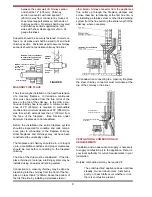
Chimney, installed in accordance with the manufac-
turers instructions or a lined masonry chimney
acceptable to the authority having jurisdiction.
CHIMNEY CONNECTORS
THE CHIMNEY CONNECTOR is a smokepipe used
to connect the Leprechaun 90 O.S.A. Stove to the
approved chimney described above. The CHIMNEY
C O N N E C TOR must be made of CORROSION
RESISTANT STEEL 24 gauge or heavier (“black” or
“blued”, or equivalent treated steel).
Be sure too fasten the chimney connectors together
and also to the flue outlet of the stove through the
holes provided. Use at least two screws for each
joint. Be sure the joints are tight and fully secured.
Chimney connectors shall not pass through an attic,
or roof space, closet or similar concealed space, or
a floor or ceiling. Where passage through a wall, or
partition of combustible construction is desired, the
installation shall conform to CAN/CSA -B 365,
Installation code for Solid Fuel Burning Appliances
and Equipment.
Connectors should maintain a pitch or rise of at least
1/4” (6mm) to the foot from the stove to the chimney.
It should be installed so as to avoid sharp turns or
other construction features that would create exces-
sive resistance to the flow of flue gases. It should be
securely supported with joints fastened with sheet-
metal screws, rivets, or other approved means. The
entire length of a connector should be readily acces-
sible for inspection, cleaning and replacement.
The connector may pass through walls or partitions
constructed of combustible materials provided the
connector is either listed for wall pass-through or is
routed through a device listed for a wall pass-
through and is installed in accordance with the con-
ditions of the listing.
Any unexposed metal that is used as part of a wall
pass-through system and is exposed to flue gases
shall be constructed of stainless steel or other equiv-
alent material that will resist corrosion, softening or
cracking from flue gas at temperatures up to 982
o
C.
CONNECTING TO MASONRY CHIMNEY
The connector to a masonry chimney must extend
through the wall to the liner face or liner but not
beyond, and must be firmly cemented to masonry.
The connector may pass through walls or partitions
constructed of combustible material to a masonry
chimney provided the connector system selected is
installed in accordance with the proper clearances
and conditions (See figures A,B,C,D page 8 & 9).
6
4.
All clearances shall be measured from the
outer surface of the combustible material to
the nearest point on the surface of the
Leprechaun 90 O.S.A., disregarding any
intervening protection applied to the com-
bustible material.
When using a manufactured wall shield system
observe local building codes and by-laws.
CHIMNEYS
Consult the LOCAL BUILDING CODE in all cases as
to the particular requirements concerning the
installation of SOLID FUEL
TYPE
ROOM
HEATERS. This Leprechaun 90 O.S.A. WOOD
BURNING STOVE is intended to be installed in
accordance
with
National
Fire
Protection
Associations Standard for Chimneys, Fireplaces
and Vents. NFPA 211-1977.
The chimney must have a CROSS SECTIONAL
AREA of at least 193.5 sq. cm. (30 sq. inches). It is
best connected to a chimney of the same size, as
connection to a larger size may result in somewhat
less draught.
The Leprechaun 90 O.S.A. is a Radiant Room
Heater and must be connected to a chimney of the
proper size and type, capable of providing an ade-
quate continuous draught of 0.06wg minimum. It is
best to connect to a chimney of the same size as the
stove spigot. DO NOT CONNECT TO A CHIMNEY
SERVING ANOTHER APPLIANCE.
Minimum chimney height is 14’ 10” (4.5m) from floor
on which stove is installed. An existing masonry
chimney should be inspected, and if necessary,
repaired by a competent mason or relined, using an
approved relining system. The stove must be
connected to a chimney with a minimum continuous
draught of 0.06”wg. Poor draught conditions will
result in poor performance.
Note: Connection to type “B” Gas Vents, approved
for connection to a certain gas burning appliance will
only result in a fire.
CHIMNEY TYPES - USA ONLY
The stove must be connected to a UL 103 Listed
residential Type HT and Building Heating, Appliance
chimney installed in accordance with the manufac-
turers instructions or a masonry chimney
constructed in accordance with NFPA 211 Chimney
vents and Solid Fuel Burning Appliances.
CHIMNEY TYPES - CANADA ONLY
The stove must be connected to an Underwriters
Laboratories of Canada labelled Factory Built 650
o
C






























